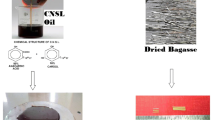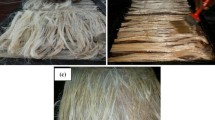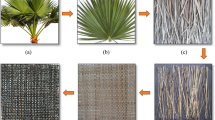Abstract
The use of synthetic fibers as reinforcement has been restricted as a result of enhanced ecological awareness and stringent laws and regulations by government agencies. Consequently, engineers and researchers are now developing sustainable composites using natural fibers. The goal of this experimental study is to develop sustainable biocomposites with improved structural, static, dynamic, mechanical, and dielectric characteristics using cashew nut shell biomass-based polymer and Bambusa tulda fiber. Fiber from Bambusa tulda has been extracted and subjected to various NaOH solution concentrations (2 to 10% with an interval of 2 (w/v)). The composite has been developed with 30% fiber loaded differently treated bamboo fiber and characterized by performing XRD, FTIR, tensile testing, DMA, and different dielectric tests. The result revealed that chemical treatment increased the crystallinity index of the biocomposites. The maximum crystallinity index has been observed as 51.73% with 6% NaOH-treated bamboo fiber reinforced biocomposites. The maximum tensile strength and storage modulus have been reported as 132.91 MPa and 8378 MPa, respectively for 6% NaOH-treated fiber reinforced biocomposites (BFC_30_T6). BFC_30_T6 exhibits higher properties because of the increased crystallinity index of fiber and better interfacial interaction between fiber and polymer matrix after the chemical treatment. Chemical treatment with more than 6% NaOH concentration reduces the dielectric constant, dielectric loss, and ac conductivity of the composites. Conversely, treatment with 8 and 10% NaOH concentrations results in a quick increase in dielectric and conductivity values.












Similar content being viewed by others
Data availability
The data supporting the finding of the manuscripts are available with the corresponding author upon reasonable request.
References
Chen H (n.d.) Chemical composition and structure of natural lignocellulose. https://doi.org/10.1007/978-94-007-6898-7__2
Lila MK, Komal UK, Singh Y, Singh I (2022) Extraction and characterization of munja fibers and its potential in the biocomposites. J Nat Fibers 19:2675–2693. https://doi.org/10.1080/15440478.2020.1821287
Rani M, Choudhary P, Krishnan V, Zafar S (2021) A review on recycling and reuse methods for carbon fiber/glass fiber composites waste from wind turbine blades. Compos B Eng 215. https://doi.org/10.1016/j.compositesb.2021.108768
Lila MK, Saini GK, Kannan M, Singh I (2017) Effect of fiber type on thermal and mechanical behavior of epoxy based composites. Fibers Polym 18:806–810. https://doi.org/10.1007/s12221-017-1147-0
Chandrika VS, Anamika A, Jeeva C et al (2022) Natural fiber incorporated polymer matrix composites for electronic circuit board applications. Adv Mater Sci Eng 2022. https://doi.org/10.1155/2022/3035169
Chauhan V, Kärki T, Varis J (2022) Review of natural fiber-reinforced engineering plastic composites, their applications in the transportation sector and processing techniques. J Thermoplast Compos Mater 35:1169–1209. https://doi.org/10.1177/0892705719889095
Murthy V, Ramakrishna S (2022) A review on global E-waste management: urban mining towards a sustainable future and circular economy. Sustainability (Switzerland) 14. https://doi.org/10.3390/su14020647
Ha LT (2022) Socioeconomic and resource efficiency impacts of digital public services. Environ Sci Pollut Res 29:83839–83859. https://doi.org/10.1007/s11356-022-21408-2
Kumar A, Holuszko M, Espinosa DCR (2017) E-waste: an overview on generation, collection, legislation and recycling practices. Resour Conserv Recycl 122:32–42. https://doi.org/10.1016/j.resconrec.2017.01.018
Shahabuddin M, Uddin MN, Chowdhury JI et al (2022) A review of the recent development, challenges, and opportunities of electronic waste (e-waste). Int J Environ Sci Technol. https://doi.org/10.1007/s13762-022-04274-w
Dash C, Bisoyi DK (2022) Study on dielectric and charge transport behavior in alkali-treated randomly oriented Sunn Hemp fiber Reinforced epoxy composite in connection with the microstructure of fiber. J Nat Fibers 19:6214–6229. https://doi.org/10.1080/15440478.2021.1907830
Wu CS, Wu DY, Wang SS (2022) Preparation and characterization of polylactic acid/bamboo fiber composites. ACS Appl Bio Mater 5:1038–1046. https://doi.org/10.1021/acsabm.1c01082
Saha A, Kumari P (2022) Functional fibers from Bambusa tulda (Northeast Indian species) and their potential for reinforcing biocomposites. Mater Today Commun 31. https://doi.org/10.1016/j.mtcomm.2022.103800
Lai CY, Sapuan SM, Ahmad M et al (2005) Mechanical and dielectric properties of coconut coir fiber-reinforced polypropylene composites. Polym-Plast Technol Eng 44:619–632. https://doi.org/10.1081/PTE-200057787
Chand N, Nigrawal A, Jain D (2008) Dielectric behavior of maleic anhydride grafted polypropylene (MAgPP) modified sisal fiber reinforced PP composites. J Nat Fibers 5:270–288. https://doi.org/10.1080/15440470802252198
Amor Ib, Ghallabi Z, Kaddami H et al (2010) Experimental study of relaxation process in unidirectional (epoxy/palm tree fiber) composite. J Mol Liq 154:61–68. https://doi.org/10.1016/j.molliq.2010.04.006
Patra A, Bisoyi DK (2011) Investigation of the dielectric and mechanical properties of short sisal fiber-reinforced epoxy composite in correlation with structural parameters of the reinforced fiber. J Mater Sci 46:7206–7213. https://doi.org/10.1007/s10853-011-5676-4
Triki A, Guicha M, Ben Hassen M et al (2011) Studies of dielectric relaxation in natural fibres reinforced unsaturated polyester. J Mater Sci 46:3698–3707. https://doi.org/10.1007/s10853-010-5136-6
Bhuvaneswari HB, Vinayaka DL, Ilangovan M, Reddy N (2017) Completely biodegradable banana fiber-wheat gluten composites for dielectric applications. J Mater Sci: Mater Electron 28:12383–12390. https://doi.org/10.1007/s10854-017-7058-4
Dash C, Bisoyi DK (2022) Experimental investigation of structural stabilization in Sunn Hemp fiber and its influence on flexural, tensile, dielectric properties of reinforced composite. J Mater Sci: Mater Electron 33:13075–13094. https://doi.org/10.1007/s10854-022-08248-z
Radzi AM, Zaki SA, Hassan MZ et al (2022) Bamboo-fiber-reinforced thermoset and thermoplastic polymer composites: a review of properties, fabrication, and potential applications. Polymers (Basel) 14. https://doi.org/10.3390/polym14071387
Khan Z, Yousif BF, Islam M (2017) Fracture behaviour of bamboo fiber reinforced epoxy composites. Compos B Eng 116:186–199. https://doi.org/10.1016/j.compositesb.2017.02.015
Zakikhani P, Zahari R, Sultan MTH, Majid DL (2017) Morphological, mechanical, and physical properties of four bamboo species. BioResources 12:2479–2495
Depuydt DEC, Soete J, Asfaw YD et al (2019) Sorption behaviour of bamboo fibre reinforced composites, why do they retain their properties? Compos Part A Appl Sci Manuf 119:48–60. https://doi.org/10.1016/j.compositesa.2019.01.020
Hassan MZ, Roslan SA, Sapuan SM et al (2020) Mercerization optimization of bamboo (Bambusa vulgaris) fiber-reinforced epoxy composite structures using a Box-Behnken design. Polymers (Basel) 12:. https://doi.org/10.3390/POLYM12061367
Salih AA, Zulkifli R, Azhari CH (2020) Tensile properties and microstructure of single-cellulosic bamboo fiber strips after alkali treatment. Fibers 8. https://doi.org/10.3390/FIB8050026
Zhang K, Wang F, Liang W et al (2018) Thermal and mechanical properties of bamboo fiber reinforced epoxy composites. Polymers (Basel) 8. https://doi.org/10.3390/polym10060608
Saha A, Kumari P (2023) Effect of alkaline treatment on physical, structural, mechanical and thermal properties of Bambusa tulda (Northeast Indian species) based sustainable green composites. Polym Compos. https://doi.org/10.1002/pc.27256
Kaima J, Preechawuttipong I, Peyroux R et al (2023) Experimental investigation of alkaline treatment processes (NaOH, KOH and ash) on tensile strength of the bamboo fiber bundle. Results Eng 18:. https://doi.org/10.1016/j.rineng.2023.101186
Fang X, Xu J, Guo H, Liu Y (2023) The effect of alkali treatment on the crystallinity, thermal stability, and surface roughness of bamboo fibers. Fibers Polym. https://doi.org/10.1007/s12221-023-00093-z
Guo C, Li M, Wang S et al (2023) Alkali treatment of bamboo fibers improves the mechanical properties of metakaolin geopolymer. J Dispers Sci Technol. https://doi.org/10.1080/01932691.2023.2190391
Liu M, Hou D, Zheng K, Gao C (2023) Characterization of friction and wear of phenolic resin matrix composites reinforced by bamboo fibers of alkaline and LaCl3 treatment. Mater Today Commun 35:. https://doi.org/10.1016/j.mtcomm.2023.106361
Corigliano P, Crupi V, Bertagna S, Marinò A (2021) Bio-based adhesives for wooden boatbuilding. J Mar Sci Eng 9:1–18. https://doi.org/10.3390/jmse9010028
Kumar R, Bhowmik S (2019) Elucidating the coir particle filler interaction in epoxy polymer composites at low strain rate. Fibers Polym 20:428–439. https://doi.org/10.1007/s12221-019-8329-x
Komal UK, Kasaudhan BK, Singh I (2021) Comparative performance analysis of polylactic acid parts fabricated by 3D printing and injection molding. J Mater Eng Perform 30:6522–6528. https://doi.org/10.1007/s11665-021-05889-9
Hu M, Wang C, Lu C et al (2020) Investigation on the classified extraction of the bamboo fiber and its properties. J Nat Fibers 17:1798–1808. https://doi.org/10.1080/15440478.2019.1599311
Standard test method for tensile properties of plastics. https://doi.org/10.1520/D0638-14
Gouanve F, Meyer M, Grenet J et al (2006) Unsaturated polyester resin (UPR) reinforced with flax fibers, untreated and cold He plasma-treated: thermal, mechanical and DMA studies. In: Compos Interfaces. pp 355–364. https://doi.org/10.1163/156855406777408548
Komal UK, Lila MK, Singh I (2021) Processing of PLA/pineapple fiber based next generation composites. Mater Manuf Process 36:1677–1692. https://doi.org/10.1080/10426914.2021.1942904
Bisoyi DK, Oram SK, Dash C (2022) A mechanical and dielectric study on calcium hydroxide pre-treated kapok husk-reinforced epoxy composites. Polym Bull 79:4923–4939. https://doi.org/10.1007/s00289-021-03744-4
Moshi AAM, Ravindran D, Bharathi SRS et al (2020) Characterization of a new cellulosic natural fiber extracted from the root of Ficus religiosa tree. Int J Biol Macromol 142:212–221. https://doi.org/10.1016/j.ijbiomac.2019.09.094
Shanmugam V, Mensah RA, Försth M et al (2021) Circular economy in biocomposite development: State-of-the-art, challenges and emerging trends. Compos Part C: Open Access 5. https://doi.org/10.1016/j.jcomc.2021.100138
Zhuo G, Zhang X, Jin X et al (2020) Effect of Different Enzymatic Treatment on Mechanical, Water Absorption and Thermal Properties of Bamboo Fibers Reinforced Poly (Hydroxybutyrate-co-Valerate) Biocomposites. J Polym Environ 28:2377–2385. https://doi.org/10.1007/s10924-020-01781-0
Li Y, Jiang L, Xiong C, Peng W (2015) Effect of Different Surface Treatment for Bamboo Fiber on the Crystallization Behavior and Mechanical Property of Bamboo Fiber/Nanohydroxyapatite/Poly(lactic-co-glycolic) Composite. Ind Eng Chem Res 54:12017–12024. https://doi.org/10.1021/acs.iecr.5b02724
Chen Z, Du K, Yin H et al (2023) Surface modification of bamboo fiber with dopamine associated by laccase for poly(3-hydroxylbutyrate) biocomposites. J Clean Prod 389. https://doi.org/10.1016/j.jclepro.2023.135996
Hu F, Li L, Wu Z et al (2022) Surface Characteristics of Thermally Modified Bamboo Fibers and Its Utilization Potential for Bamboo Plastic Composites. Materials 15. https://doi.org/10.3390/ma15134481
Chang F, Kwon JH, Kim NH, Endo T, Lee SH (2015) Effect of hot-compressed water treatment of bamboo fiber on the properties of polypropylene/bamboo fiber composite. Bioresources. Jan 12;10(1):1366–77. https://doi.org/10.15376/biores.10.1.1366-1377
Liu W, Chen T, Wen X et al (2014) Enhanced mechanical properties and water resistance of bamboo fiber–unsaturated polyester composites coupled by isocyanatoethyl methacrylate. Wood Sci Technol 48:1241–1255. https://doi.org/10.1007/s00226-014-0668-6
Rajeshkumar G, Devnani GL, Maran JP et al (2021) Characterization of novel natural cellulosic fibers from purple bauhinia for potential reinforcement in polymer composites. Cellulose 28:5373–5385. https://doi.org/10.1007/s10570-021-03919-2
Ismail AS, Jawaid M, Hamid NH et al (2023) Physical, structural and thermal properties of bio-phenolic/epoxy polymers blends. Mater Today Commun 34:105455. https://doi.org/10.1016/j.mtcomm.2023.105455
Lekrine A, Belaadi A, Makhlouf A et al (2022) Structural, thermal, mechanical and physical properties of Washingtonia filifera fibres reinforced thermoplastic biocomposites. Mater Today Commun 31:. https://doi.org/10.1016/j.mtcomm.2022.103574
Chin SC, Tee KF, Tong FS et al (2020) Thermal and mechanical properties of bamboo fiber reinforced composites. Mater Today Commun 23. https://doi.org/10.1016/j.mtcomm.2019.100876
Komal UK, Lila MK, Singh I (2020) PLA/banana fiber based sustainable biocomposites: A manufacturing perspective. Compos B Eng 180. https://doi.org/10.1016/j.compositesb.2019.107535
Komal UK, Singh I (2022) Sustainable Treatments of Pineapple Leaf Fibers for Polylactic Acid Based Biocomposites. J Nat Fibers 19:13438–13456. https://doi.org/10.1080/15440478.2022.2095550
Amroune S, Bezazi A, Belaadi A et al (2015) Tensile mechanical properties and surface chemical sensitivity of technical fibres from date palm fruit branches (Phoenix dactylifera L.). Compos Part A Appl Sci Manuf 71:95–106. https://doi.org/10.1016/j.compositesa.2014.12.011
Fleck NA, Deshpande VS, Ashby MF (2010) Micro-architectured materials: Past, present and future. In: Proc R Soc A: Math Phys Eng Sc R Soc 2495–2516. https://doi.org/10.1098/rspa.2010.0215
Baishya MJ, Sahariah BJ, Muthu N, Khanikar P (2022) Composite strut-plate lattice: A high-stiffness design of cellular metamaterial having excellent strength and energy absorption ability. Mater Today Commun 33. https://doi.org/10.1016/j.mtcomm.2022.104939
Saba N, Jawaid M, Alothman OY, Paridah MT (2016) A review on dynamic mechanical properties of natural fibre reinforced polymer composites. Constr Build Mater 106:149–159. https://doi.org/10.1016/j.conbuildmat.2015.12.075
Arvinda Pandian CK, Siddhi Jailani H (2018) Investigation of viscoelastic attributes and vibrational characteristics of natural fabrics-incorporated hybrid laminate beams. Polym Bull 75:1997–2014. https://doi.org/10.1007/s00289-017-2139-3
Ramakrishnan S, Krishnamurthy K, Rajeshkumar G, Asim M (2021) Dynamic Mechanical Properties and Free Vibration Characteristics of Surface Modified Jute Fiber/Nano-Clay Reinforced Epoxy Composites. J Polym Environ 29:1076–1088. https://doi.org/10.1007/s10924-020-01945-y
Chaudhary V, Bajpai PK, Maheshwari S (2018) An Investigation on Wear and Dynamic Mechanical behavior of Jute/Hemp/Flax Reinforced Composites and Its Hybrids for Tribological Applications. Fibers Polym 19:403–415. https://doi.org/10.1007/s12221-018-7759-6
Saw S, Sarkhel G, Choudhury A (2011) Dynamic mechanical analysis of randomly oriented short bagasse/coir hybrid fibre-reinforced epoxy novolac composites. Fibers Polym 12:506–513
Jawaid M, Abdul Khalil HPS, Hassan A et al (2013) Effect of jute fibre loading on tensile and dynamic mechanical properties of oil palm epoxy composites. Compos B Eng 45:619–624. https://doi.org/10.1016/j.compositesb.2012.04.068
Kumar S, Zindani D, Bhowmik S (2020) Investigation of Mechanical and Viscoelastic Properties of Flax- and Ramie-Reinforced Green Composites for Orthopedic Implants. J Mater Eng Perform 29:3161–3171. https://doi.org/10.1007/s11665-020-04845-3
Dash C, Das A, Kumar Bisoyi D (2020) Influence of pretreatment on mechanical and dielectric properties of short Sunn Hemp fiber-reinforced polymer composite in correlation with fine structure of the fiber. J Compos Mater 54:3313–3327. https://doi.org/10.1177/0021998320914071
Bhuvaneswari HB, Reddy N (2018) A review on dielectric properties of biofiber-based composites. Adv Compos Hybrid Mater 1:635–648. https://doi.org/10.1007/s42114-018-0053-2
Dash C, Das R, Sahu DK et al (2023) Investigation of dielectric and mechanical properties of pretreated natural Sunn Hemp fiber-reinforced composite in correlation with macromolecular structure of the fiber. Biomacromol. https://doi.org/10.1021/acs.biomac.2c01370
Reddy PV, Reddy RVS, Reddy BV et al (2022) Enhancement of the dynamic mechanical and dielectric properties of Prosopis juliflora fiber-reinforced composites by fiber modification. J Nat Fibers 19:6780–6796. https://doi.org/10.1080/15440478.2021.1932676
Omri MA, Triki A, Ben Hassen M et al (2019) Effect of Alfa fiber mechanical separation on dielectric properties of hybrid unsaturated polyester composites. Polym Compos 40:1774–1785. https://doi.org/10.1002/pc.24934
Acknowledgements
The authors would like to thank CIF, the Center for the Environment and Smart Materials and Structures Lab, IIT Guwahati, for providing the different testing facilities. The authors are also grateful to Cardolite Specialty Chemicals India LLP, Mangalore, India, for providing bio-epoxy free of cost.
Funding
This experimental investigation is supported by DST (grant no. TDP/BDTD/03/2021(G)), Govt. of India.
Author information
Authors and Affiliations
Contributions
Abir Saha: investigation, methodology, writing—original draft and review and editing.
Nikhil Dilip Kulkarni: investigation, methodology, writing—review and editing.
Mukesh Kumar: investigation, methodology.
Poonam Kumari: Supervision, writing—review and editing.
Corresponding author
Ethics declarations
Ethical approval
Not applicable.
Competing interests
The authors declare no competing interests.
Additional information
Publisher's note
Springer Nature remains neutral with regard to jurisdictional claims in published maps and institutional affiliations.
Supplementary Information
Below is the link to the electronic supplementary material.
Rights and permissions
Springer Nature or its licensor (e.g. a society or other partner) holds exclusive rights to this article under a publishing agreement with the author(s) or other rightsholder(s); author self-archiving of the accepted manuscript version of this article is solely governed by the terms of such publishing agreement and applicable law.
About this article
Cite this article
Saha, A., Kulkarni, N.D., Kumar, M. et al. The structural, dielectric, and dynamic properties of NaOH-treated Bambusa tulda reinforced biocomposites—an experimental investigation. Biomass Conv. Bioref. (2023). https://doi.org/10.1007/s13399-023-04709-5
Received:
Revised:
Accepted:
Published:
DOI: https://doi.org/10.1007/s13399-023-04709-5




